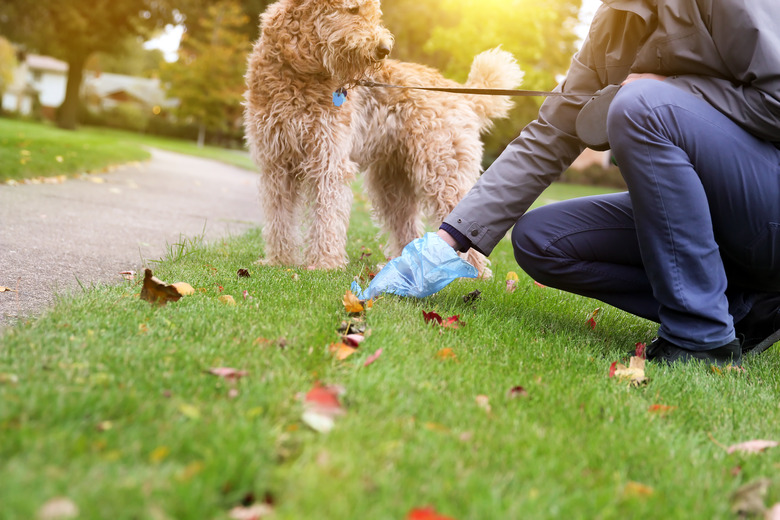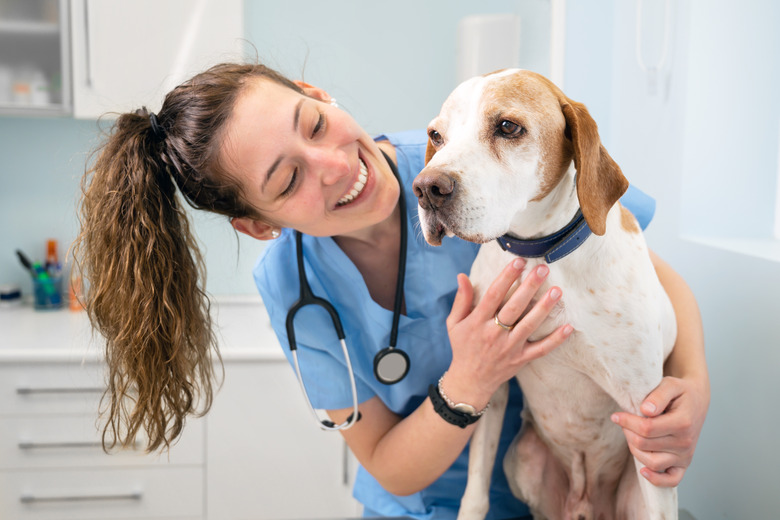Types Of Worms In Dog Poop
Your dog's attitude, weight, and even the shine of his coat can give you important clues to his health. If your dog has a health issue like an upset stomach, you will often know about it pretty quickly. However, if you spot white specks in dog poop, your dog might have an underlying health issue about which you would not otherwise know. Intestinal parasites, also known as "worms," can cause many symptoms in dogs, and sometimes the first clue to their presence comes through worms in dog poop.
How your dog gets worms
According to the American Veterinary Medical Association, your dog can become infected with intestinal parasites including roundworms, hookworms, whipworms, and tapeworms by ingesting eggs. When a dog is infected, the worms lay eggs that the dog then passes through their stool, but you may not notice worm eggs in dog poop. You can't actually see the eggs because they are microscopic, but tapeworm segments contain eggs.
Your dog can come into contact with the eggs in many different ways. She may eat soil that has been contaminated or even ingest another dog's stool that is carrying the eggs. The eggs could also potentially contaminate water, or your dog may lick their paws or fur after traveling through grass that is contaminated with eggs.
Once your dog ingests the eggs, they will hatch and grow inside of your canine companion, starting the cycle all over again. Tapeworms spread just a bit differently. They are also passed in an infected dog's stool, but then your dog will become infected when she eats fleas, lice, or rodents that have ingested the eggs.
What makes dogs at risk for worms
If your dog frequently socializes with other dogs in areas such as dog parks, he is at an increased risk of contracting intestinal parasites. This is particularly true if he is in an area where owners don't actively clean up after dogs defecate or if you allow them to ingest another dog's poop.
Your geographic area can also factor into how likely your dog is to get worms. Intestinal parasites are a major problem in the Southeast because of the lack of frost cycles that kill off the parasites. In the Southeast, the soil is so contaminated that dogs are almost guaranteed to get intestinal parasites at some point in their lives. Roundworm eggs can live for years if there is not a hard freeze.
On the other hand, areas that do receive a hard freeze each winter have less of an issue with worms. Because the frost kills off the parasite eggs, intestinal parasites in dogs become more of a summer issue rather than being a year-round concern in those areas.
Stringy worms in dog poop
If you notice white specks in dog poop or a stringy consistency, then you may be seeing intestinal parasites that your dog has expelled. Worms will occasionally appear in your dog's stool. If your dog is infected with adult roundworms or hookworms, they will look like off-white or tan, spaghetti-shaped parasites.
Tapeworms have a different appearance and can sometimes be seen clinging to the hair around your dog's genitals. If the worms are fresh, they will be white and will measure about one-fourth inch to one-half inch long. Dry, dead worm segments look like sesame seeds or rice grains.
If you spot white things in dog poop, or see yellow spots in your dog's poop, then it is a good idea to have your dog tested for worms. However, just because you don't see worms in your dog's poop doesn't mean that your dog is not infected. It is possible for your dog to carry intestinal parasites without being able to see them in their stool.
Identifying dog worms and intestinal parasites
Your pet may demonstrate a number of symptoms indicating that she has intestinal parasites. Weight loss and a general poor appearance are common symptoms of worms in dogs. Your canine companion may also have an unusually dry coat. She may vomit or have diarrhea, and you may notice worms in the vomit or diarrhea.
It is also possible for your dog to be infected with worms but not show any of these symptoms. Some eggs may lie dormant in your dog until your dog is stressed. Plus, the parasites work hard to remain in your dog's digestive tract since they will die if they are passed outside of your dog's body.
Because you can't always visibly confirm the presence of worms, your vet will rely on fecal tests to determine which types of worms are present. By looking at stool samples under a microscope, your vet can identify worm eggs and then treat your dog appropriately.
Roundworms in dogs
Roundworms are the most common canine gastrointestinal worm, and many puppies are born with roundworm larvae because of exposure to it in their mother's uterus. The mother's milk can also transfer the larvae to a puppy. Once ingested, the larvae travel to the puppy's digestive tract. They shed eggs and live in the puppy's small intestine.
A female roundworm can lay an amazing 200,000 eggs per day, and those eggs can live in soil for up to four years. If a puppy has a roundworm infection, he may have a pot belly and be in poor health. You may not always notice worms in puppy poop. It is important to act quickly to get the puppy treated since roundworm infestations can block a puppy's intestines, causing death.
Adult dogs are also at risk of being infected with roundworms. That's because they can pick up roundworm eggs when they lick or ingest infected dog stool, or they can also get it from ingesting birds, rodents, earthworms, or even cockroaches. Wormers generally only affect adult parasites in the dog's intestinal tract, meaning that eggs and larvae located elsewhere in the body can withstand deworming.
Hookworms in dogs
Hookworms are small, thin worms that live in the small intestine. They're more common in moist, warm environments. Like roundworms, hookworm larvae can be transferred to a puppy through their mother's milk and through the placenta before the puppy is born. Severe hookworm infections can kill puppies since the blood-sucking parasite causes anemia.
You may or may not notice hookworms in dog poop, but you should take them to see their vet if you have any suspicions they may have an infection. In older dogs, hookworms can lead to weight maintenance issues, reduced stamina, bloody diarrhea, anemia, and progressive weakness.
Whipworms in dogs
Whipworms are parasites that are found in the large intestines of dogs that are rarely seen in a dog's stool. However, if you do see one, it may look like a tiny piece of thread. Whipworms shed few eggs compared to other parasites, and they live in the cecum of your dog's large intestine.
Because whipworms shed so few eggs, it can be difficult to confirm their presence through a stool sample. Your vet may diagnose whipworms based on your dog's symptoms. Whipworms often cause chronic weight loss, and an infected dog's stool is often covered in mucous.
Whipworms rarely cause death in dogs, but they can cause digestive upset and be a general nuisance for both you and your dog. Whipworms often cause chronic diarrhea, but an infected dog may otherwise seem quite happy and healthy. Thankfully, whipworms are the least common of the intestinal parasites.
Tapeworms in dogs
Flea larvae eat tapeworm eggs, so if a dog ingests fleas or rodents that are infested with fleas, they can become infected with tapeworms. Tapeworms look like a multi-segmented worm, and they have a small head on one end.
When fully grown, tapeworms can be between four and six inches long. A single tapeworm may have as many as 90 different segments to its body. As tapeworms grow, they release their last segments. These are the segments that you may notice in your dog's stool or attached to the fur near your dog's genitals. The segments may move around a bit outside of your dog's body before they dry up. These segments contain tapeworm eggs.
Fecal tests are effective in diagnosing a wide variety of parasites. However, tapeworms are an exception because they don't tend to shed eggs. The eggs are inside the segments they shed. Therefore, when testing a dog for tapeworms, a test comes up negative, you might still see tapeworm segments in your dog's stool.
The dewormers that you can purchase over the counter cannot kill tapeworms. If you notice signs of tapeworms in your dog, go to your veterinarian for a prescription wormer that is effective against tapeworms. Also, be sure to wash your dog's bed with hot water and thoroughly wash any blankets and other bedding where your dog may have slept.
Treating worms in dogs
If you find worms in your dog's poop or suspect that your dog may have worms, then you should schedule an appointment with your vet. Your vet will either collect a stool sample or ask you to bring a stool sample to test for worm eggs. It needs to be a stool sample that your dog passed that same day.
Once your vet knows what type of worms your dog has, he will prescribe an appropriate deworming product. There are about weight different deworming medications available. While the medications are largely safe, they can cause a lack of energy and appetite in your dog as they work to expel the worms.
Your vet will advise you on the right medication and its dosage and administration for your dog. You can expect to see worms in your dog's stool for a few days after administering the dewormer.
Preventing worms in dogs
Preventing your dog from getting intestinal parasites in the first place is the best way to keep your dog healthy. Prevention starts with cleaning up after your dog promptly. Picking up your dog's poop helps to prevent eggs from contaminating the ground, making the environment safer for all dogs.
It is also a good idea to bathe your dog frequently so you can clean up any fecal material with which he may have come into contact while outdoors. By removing this material before your dog bathes themself, you may be able to stop them from becoming infected with worm eggs.
Yearly vet visits are also important in maintaining your dog's health. Your vet will probably recommend an annual fecal screening so that you can catch worm infestations early on and treat them appropriately. Using a monthly heartworm and flea preventative can help to control some other types of worms, too.
Preventing human infection
Pinworms, the most common worm infection that humans get in the United States, is not from dogs, according to the Centers for Disease Control and Prevention. However, it is possible for humans to become infected by the same worms that their dogs carry. If you or a child touch a dog with fecal material on their fur and then touch your mouth or food, you can be infected with worms. Hookworm larvae (not the adult hookworms) can pass through the skin if you walk barefoot outdoors.
Children are particularly at risk because they play in sandboxes and beaches where dogs may have defecated, and they also tend to spend a lot of time barefoot. Younger children may not yet understand the importance of washing their hands, and they also tend to put things in their mouths. This is serious because roundworm larvae can migrate to the eye (usually just one eye) and can cause vision loss in people, especially children. This type of infection in the eye can also be misdiagnosed as a type of cancer (retinoblastoma) in infants and children.
Worms can also cause a skin infection, and this can sometimes be useful in identifying the type of worm present. If you suspect that you or a child have been infected with worms, then see your doctor immediately. An appropriate deworming medication will usually resolve the issue, but follow-up stool tests may be needed.
References
- American Veterinary Medical Association: Disease Risks for Dogs in Social Settings
- Banfield Pet Hospital: Worms in Dogs and Puppies: What to Do
- Centers for Disease Control and Prevention: Pinworms
- Care: Worms in Dogs: What Are the Types, Symptoms and Treatments
- Centers for Disease Control and Prevention: Dipylidium FAQ
- National Library of Medicine: Gastrointestinal Parasites in Shelter Dogs: Occurrence, Pathology, Treatment and Risk to Shelter Workers
- The Ohio State University College of Veterinary Medicine: Hookworms



